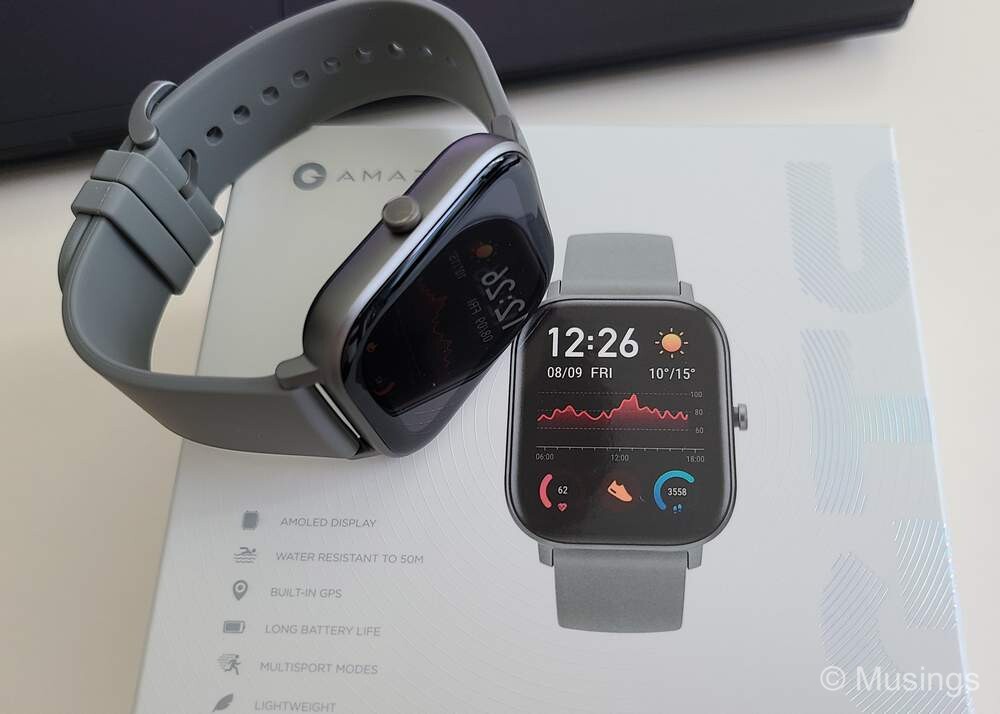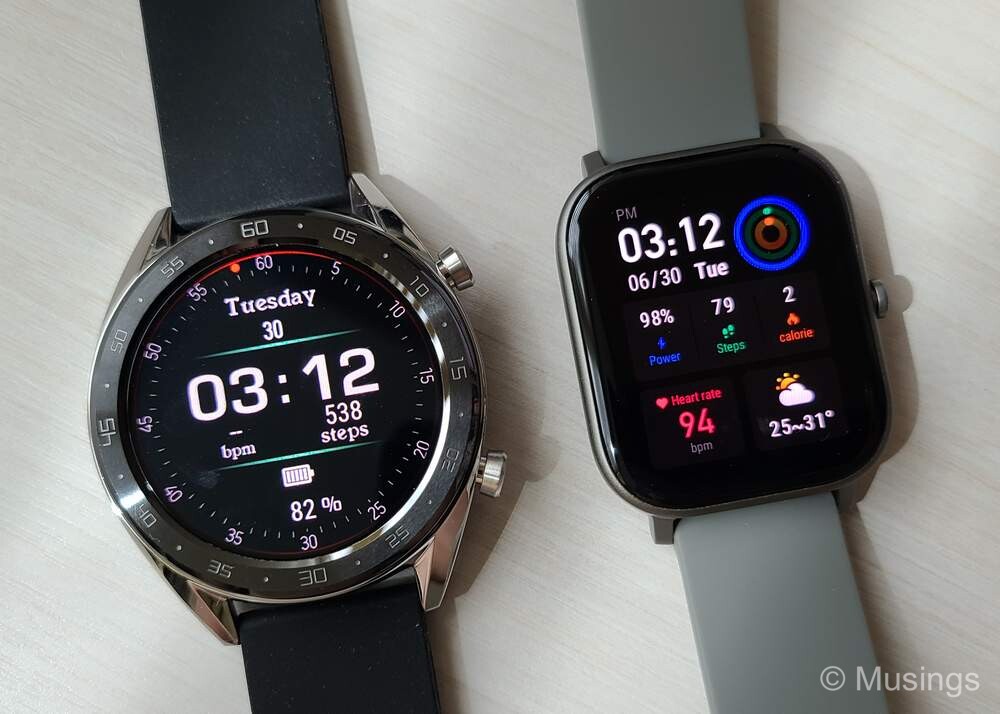Ever since picking up the Huawei Watch GT more than 18 months ago, the watch preceding that – the Samsung Gear Sport – has been returned to its box. I took it out for a while over the weekend. And oddly, after pairing it to my Samsung S20+ and installing the bunch of firmware updates over the period, the Gear Sport pretty much spontaneously went into a boot loop and refused to charge anymore. As it is, the watch no longer starts and does not charge. Gosh. RIP.
I’ve been using the Watch GT as my daily wearable for 1.5 years now, and I really like it. Its battery life continues to last around 10-12 days a charge even with its Always-On-Display enabled. The watch’s external case remains relatively free of blemishes and nicks caused from wear and tear. The only complaints I have of the device would be its weight – I can feel its 46g weight on my wrist, especially when I wear it to bed – and also a third party charging cradle I bought for it no longer snaps securely to the watch’s base plate – making it hard to obtain a solid charge connection. Not an unsolvable problem of course, since additiojnal third party charging cradles are easily obtained at SGD7-8 apiece, but it does remind me again how much I miss the Samsung Gear Sport’s support for wireless charging.
Still, I’ve been on the lookout for a non-round smartwatch just to try it out. But since this was going to be a companion piece that I can alternate with the Watch GT, I wasn’t going to spend gobs of money on it. The gold standard for smartwatches, for many tech review sites at least, continues to be the Apple Watch. But heck no – paying more than SGD599 and upwards for the Series 5 is just too much for me, especially when Apple is still only rating its watches for one day long battery longevity. Fitbit has an updated version of its Versa model, but that’s a sports-oriented watch. Moreover, having experienced the 14 day battery life put out by the Watch GT, it’s just hard to return to smartwatches that don’t at least last a week.
One watch did catch my attention though: the Amazfit GTS. I still have the Amazfit Bip that I picked up 2 years ago – that little thing is cute, but not really enjoyable to use with its lackluster display. The GTS isn’t a particularly new model: it was announced in December 2019, and widely available here from the start of this year. Initially, the local listed price was around SGD200, but there was no compelling reason for me to go for it then at launch: the Watch GT was (and still is) serving me fabulously well at that point. But six months into 2020 and without an equally competitive rectangular-face smartwatch with similarly long battery life in the horizon, I figured I might as well give that one a go. The street price of the GTS from online resellers have also dropped quite a bit, and I picked one up for SGD170 after applying discounts to it – it’s even cheaper if you’re willing to forgo manufacturer warranty and live with reseller/in-store warranty. The price difference was just around SGD15 though, so I went with a reseller offering manufacturer warranty.

My early impressions after using it a week!
Physical aspects-wise, the Amazfit GTS is very light, and at just 24.8g sans strap. The Amazift Bip is even more featherlight at 18g, but the GTS is in a different class from the Bip altogether: far better screen and display being the main difference for me. The GTS is also significantly and noticeably lighter than the Watch GT’s 46g. And coupled with the thin yet flexible silicon strap the watch comes in, I reckon my wrist is going to thank me for buying the GTS – especially when I’m wearing it while on the piano or sleeping.
The box the GTS comes in is a little oversized for its contents: it comes with the watch, a printed book containing instructions – but you really likely won’t need it if you’ve setup and used smartwatches before – and the charging cradle, which unfortunately is of the magnetic type again. Sigh. I put in an order for two third party chargers – costing around SGD 6-7 each again – immediately, and will be putting the original charger back in its box for safe-keeping once they arrive.
Pairing the watch was easy: you’d want to install the Amazfit app first. Powering up the watch throws up a QR-code that you’ll scan using the Amazfit, and the pairing is quick. However, if you’re intending to add the GTS as a trusted device to automatically unlock your phone, the process I recommend is a little different. Several other owners of wearable devices have encountered challenges getting their phones to pair with smartwatches using the native Bluetooth app. What worked for me was not to first pair your watch using the manufacturer app. Rather, pair your watch to your phone using Settings => Bluetooth. Then add your watch as a trusted device, and only thereafter pair the watch and phone using the Amazfit app. Pairing the phone and watch using the app led also to several firmware updates getting download and installed, but it got all done in about twenty minutes.
Physical characteristics-wise, the GTS has an AMOLED screen that’s gorgeous to look at. The display also has a high maximum brightness level that will help in outdoor use. I’ve found that indoor use doesn’t require a brightness level setting of more than 50%. There’s also a toggle for auto brightness that’ll let the watch automatically determine the suitable brightness level depending on ambient light, but the auto setting seems to be a tad optimistic i.e. it sets the watch display to be somewhat dim. No fine adjustments are also possible with auto brightness.
The GTS screen while diagonally long at 1.65″ when compared to the Huawei GT’s 1.39″ is actually noticeably smaller than the latter too. It’s still sufficient to display what it needs to – including message text and the various data indicators. But if you’d be disappointed if you’re hoping for the actual display area to be larger than a round one.
The watch doesn’t allocate much storage space for watch faces; you get to keep the two built-in watch faces permanently – one digital and the other analog, both of which are also somewhat configurable – and space for a third that you download in the app and sync to the watch. The severe limits here are a clunker if you like rotating watch faces several times a day, as each change will mean needing to re-sync the new watch face in. The additional watch faces on the Amazfit are pleasing though and varied. Still, I settled on a few ones I liked and didn’t bother with the rest. There’s one watch face that lets you set custom background images – very nice! I couldn’t find such an equivalent on the Watch GT.
The lift wrist to wake on the GTS is also very responsive, and noticeably more so compared to Watch GT’s. I’ve typically have to wriggle my wrist to wake the Watch GT up each time, while no such is necessary for the GTS.
In general use, both the GTS and Watch GT don’t offer fluid animations. The stutters and hesitancy when swiping between displays are quite obvious, and even more apparent if you’re coming from an Apple Watch. However, these are finally limitations I can live with – especially considering the prices of watches like the GTS and Watch GT and benefiting from their week long or more battery life.
The Amazfit app isn’t as slick or polish looking as Samsung’s or Huawei’s, but it has a few useful extras that aren’t found on those two. For example, I can customize the schedule to control when the lift wrist to wake is enabled – which basically solves the problem of the watch accidentally waking when you toss and turn on the bed. Sure the Watch GT likewise has a ‘lock’ feature (the GTS has it too), but that will just mean additional steps I have to do each night before I sleep and then wake up the next morning. The app also allows me to create custom vibration alarms. Very nifty! Fancy a morse-code type of vibration alert? That’s totally possible here in the app. There are also basic music playback controls on the GTS; the Watch GT didn’t have those. Nothing too deep though: it can’t start-up your music app – just play, pause, next and previous tracks.
The stated battery capacity on the GTS is also roughly half that of the Watch GT: 220mAh vs 420mAh, and it shows in overall longevity. The Watch GT can easily last for 12-14 days in my normal use (non-sports, round the clock heart-rate monitoring, a lot of notifications and alerts sounding off), and enabling the Always-On-Display (AOD) brings it down to around 10 days or so. The longevity of the GTS in comparison seems to vary quite widely. When I’m using it without AOD and without going out of my way to fool around with it, battery drop is about 7-8% a day – which means it’ll run for just about 14 days indeed. But tinkering with it seems to drain the battery very quickly, and it’ll run for around 8 days then – and half that with AOD enabled. Not great, but still light-years ahead of the Samsung Gear Sport or Apple Watches.
As for little niggling bits and other limitations of the GTS; the vibration motor is somewhat weak, so I’ve occasionally missed alerts sounding off on the GTS. It – oddly – also isn’t able to display emojis, e.g. in WhatsApp or Facebook Messenger messages. Bummer.

That’s it for my early week-long impressions of the Amazfit GTS. Like my other blog commentaries for new gadgets and toys, I’ll do a follow-up post of this new watch later this year after I’ve spent more time on it.
Recent comments